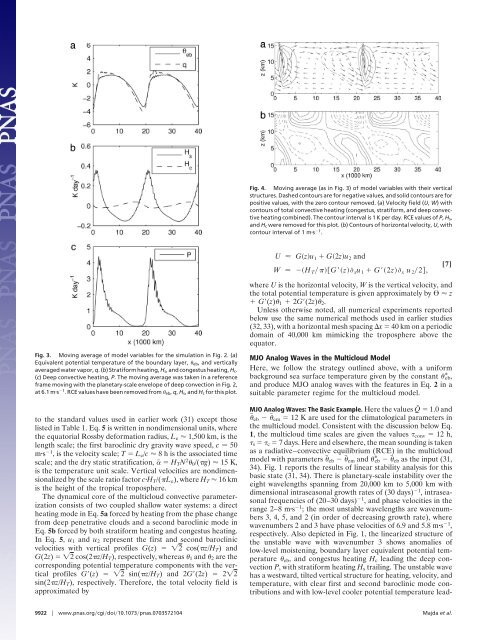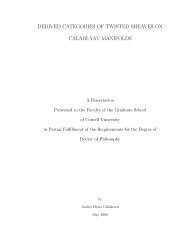Madden–Julian Oscillation analog and intraseasonal variability in a ...
Madden–Julian Oscillation analog and intraseasonal variability in a ...
Madden–Julian Oscillation analog and intraseasonal variability in a ...
You also want an ePaper? Increase the reach of your titles
YUMPU automatically turns print PDFs into web optimized ePapers that Google loves.
Fig. 3. Mov<strong>in</strong>g average of model variables for the simulation <strong>in</strong> Fig. 2. (a)<br />
Equivalent potential temperature of the boundary layer, eb, <strong>and</strong> vertically<br />
averaged water vapor, q.(b) Stratiform heat<strong>in</strong>g, Hs, <strong>and</strong> congestus heat<strong>in</strong>g, Hc.<br />
(c) Deep convective heat<strong>in</strong>g, P. The mov<strong>in</strong>g average was taken <strong>in</strong> a reference<br />
frame mov<strong>in</strong>g with the planetary-scale envelope of deep convection <strong>in</strong> Fig. 2,<br />
at 6.1 ms 1 . RCE values have been removed from eb, q, Hs, <strong>and</strong> Hc for this plot.<br />
to the st<strong>and</strong>ard values used <strong>in</strong> earlier work (31) except those<br />
listed <strong>in</strong> Table 1. Eq. 5 is written <strong>in</strong> nondimensional units, where<br />
the equatorial Rossby deformation radius, Le 1,500 km, is the<br />
length scale; the first barocl<strong>in</strong>ic dry gravity wave speed, c 50<br />
ms 1 , is the velocity scale; T Le/c 8 h is the associated time<br />
scale; <strong>and</strong> the dry static stratification, HTN 2 0/(g) 15 K,<br />
is the temperature unit scale. Vertical velocities are nondimensionalized<br />
by the scale ratio factor cHT/(Le), where HT 16 km<br />
is the height of the tropical troposphere.<br />
The dynamical core of the multicloud convective parameterization<br />
consists of two coupled shallow water systems: a direct<br />
heat<strong>in</strong>g mode <strong>in</strong> Eq. 5a forced by heat<strong>in</strong>g from the phase change<br />
from deep penetrative clouds <strong>and</strong> a second barocl<strong>in</strong>ic mode <strong>in</strong><br />
Eq. 5b forced by both stratiform heat<strong>in</strong>g <strong>and</strong> congestus heat<strong>in</strong>g.<br />
In Eq. 5, u1 <strong>and</strong> u2 represent the first <strong>and</strong> second barocl<strong>in</strong>ic<br />
velocities with vertical profiles G(z) 2 cos(z/HT) <strong>and</strong><br />
G(2z) 2 cos(2z/HT), respectively, whereas 1 <strong>and</strong> 2 are the<br />
correspond<strong>in</strong>g potential temperature components with the vertical<br />
profiles G(z) 2 s<strong>in</strong>(z/HT) <strong>and</strong> 2G(2z) 22<br />
s<strong>in</strong>(2z/HT), respectively. Therefore, the total velocity field is<br />
approximated by<br />
Fig. 4. Mov<strong>in</strong>g average (as <strong>in</strong> Fig. 3) of model variables with their vertical<br />
structures. Dashed contours are for negative values, <strong>and</strong> solid contours are for<br />
positive values, with the zero contour removed. (a) Velocity field (U, W) with<br />
contours of total convective heat<strong>in</strong>g (congestus, stratiform, <strong>and</strong> deep convective<br />
heat<strong>in</strong>g comb<strong>in</strong>ed). The contour <strong>in</strong>terval is 1 K per day. RCE values of P, Hs,<br />
<strong>and</strong> Hc were removed for this plot. (b) Contours of horizontal velocity, U, with<br />
contour <strong>in</strong>terval of 1 ms 1 .<br />
U Gzu 1 G2zu 2 <strong>and</strong><br />
W H TGz xu 1 G2z x u 22,<br />
[7]<br />
where U is the horizontal velocity, W is the vertical velocity, <strong>and</strong><br />
the total potential temperature is given approximately by z<br />
G(z)1 2G(2z)2.<br />
Unless otherwise noted, all numerical experiments reported<br />
below use the same numerical methods used <strong>in</strong> earlier studies<br />
(32, 33), with a horizontal mesh spac<strong>in</strong>g x 40 km on a periodic<br />
doma<strong>in</strong> of 40,000 km mimick<strong>in</strong>g the troposphere above the<br />
equator.<br />
MJO Analog Waves <strong>in</strong> the Multicloud Model<br />
Here, we follow the strategy outl<strong>in</strong>ed above, with a uniform<br />
background sea surface temperature given by the constant * eb,<br />
<strong>and</strong> produce MJO <strong>analog</strong> waves with the features <strong>in</strong> Eq. 2 <strong>in</strong> a<br />
suitable parameter regime for the multicloud model.<br />
MJO Analog Waves: The Basic Example. Here the values Q˜ 1.0 <strong>and</strong><br />
eb em 12 K are used for the climatological parameters <strong>in</strong><br />
the multicloud model. Consistent with the discussion below Eq.<br />
1, the multicloud time scales are given the values conv 12 h,<br />
s c 7 days. Here <strong>and</strong> elsewhere, the mean sound<strong>in</strong>g is taken<br />
as a radiative–convective equilibrium (RCE) <strong>in</strong> the multicloud<br />
model with parameters eb em <strong>and</strong> * eb eb as the <strong>in</strong>put (31,<br />
34). Fig. 1 reports the results of l<strong>in</strong>ear stability analysis for this<br />
basic state (31, 34). There is planetary-scale <strong>in</strong>stability over the<br />
eight wavelengths spann<strong>in</strong>g from 20,000 km to 5,000 km with<br />
dimensional <strong><strong>in</strong>traseasonal</strong> growth rates of (30 days) 1 , <strong><strong>in</strong>traseasonal</strong><br />
frequencies of (20–30 days) 1 , <strong>and</strong> phase velocities <strong>in</strong> the<br />
range 2–8 ms 1 ; the most unstable wavelengths are wavenumbers<br />
3, 4, 5, <strong>and</strong> 2 (<strong>in</strong> order of decreas<strong>in</strong>g growth rate), where<br />
wavenumbers 2 <strong>and</strong> 3 have phase velocities of 6.9 <strong>and</strong> 5.8 ms 1 ,<br />
respectively. Also depicted <strong>in</strong> Fig. 1, the l<strong>in</strong>earized structure of<br />
the unstable wave with wavenumber 3 shows anomalies of<br />
low-level moisten<strong>in</strong>g, boundary layer equivalent potential temperature<br />
eb, <strong>and</strong> congestus heat<strong>in</strong>g Hc lead<strong>in</strong>g the deep convection<br />
P, with stratiform heat<strong>in</strong>g Hs trail<strong>in</strong>g. The unstable wave<br />
has a westward, tilted vertical structure for heat<strong>in</strong>g, velocity, <strong>and</strong><br />
temperature, with clear first <strong>and</strong> second barocl<strong>in</strong>ic mode contributions<br />
<strong>and</strong> with low-level cooler potential temperature lead-<br />
9922 www.pnas.orgcgidoi10.1073pnas.0703572104 Majda et al.
















